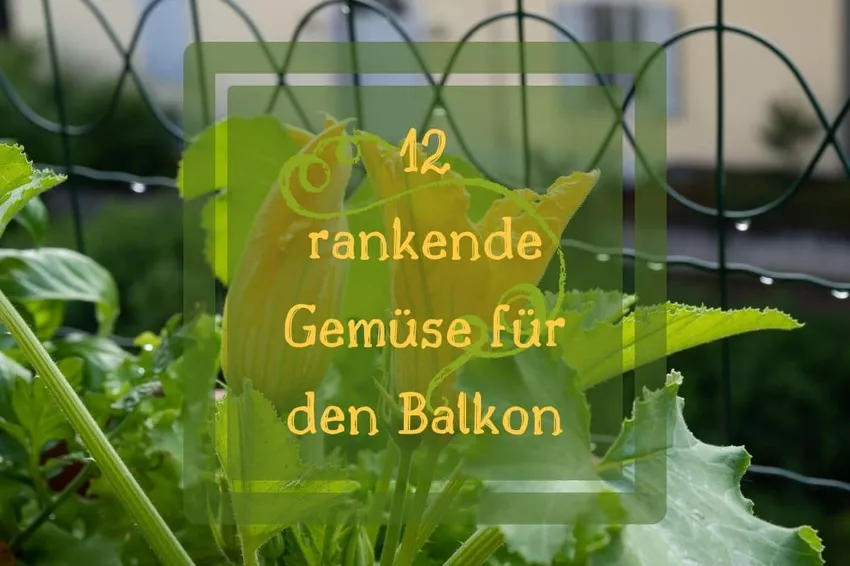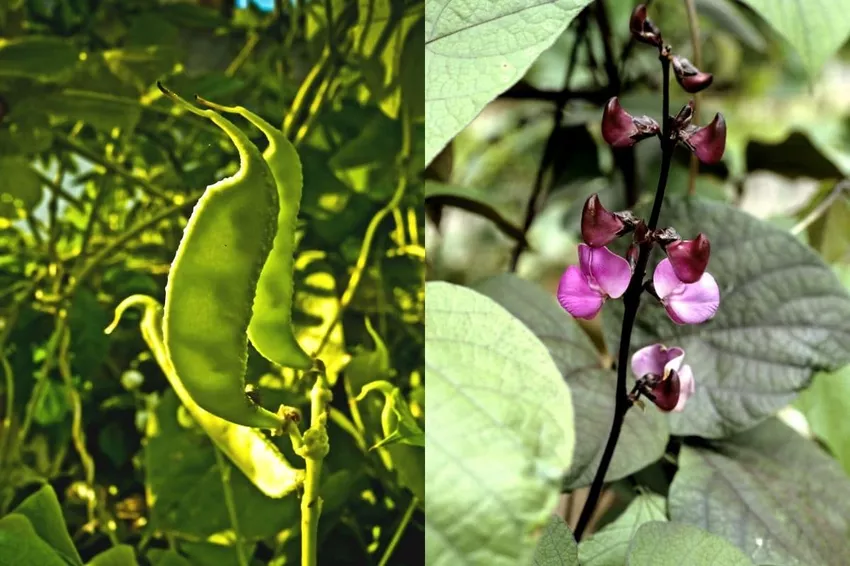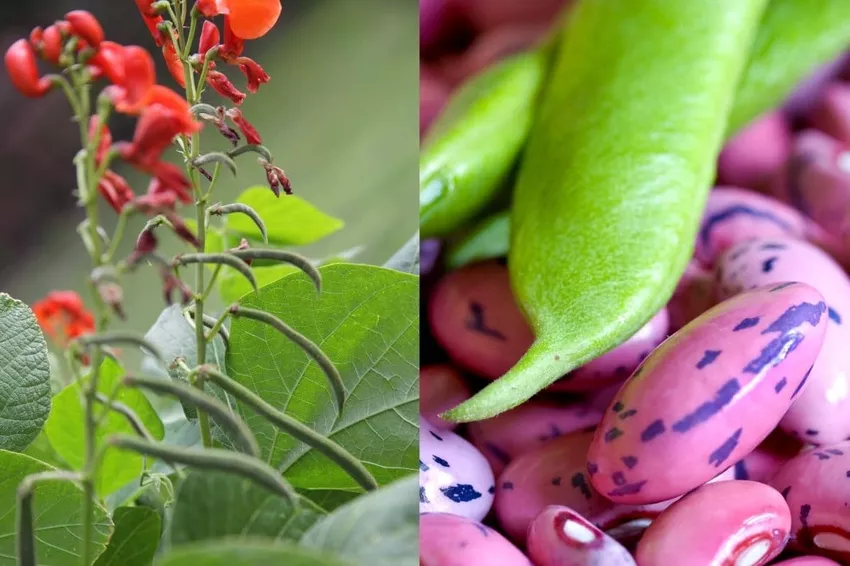- Bitter melon (Momordica charantia)
- Helmet Bean (Dolichos lablab)
- Squirrel Squash (Cyclanthera pedata)
- Caucasian spinach (Hablitzia tamnoides)
- Climbing Zucchini 'Black Forest' (Cucurbita pepo)
- Malabar spinach (Basella alba)
- Mexican mini cucumber (Melothria scabra)
- Mini cucumber 'Picolino' (Cucumis sativus)
- Pepper 'Pinokkio' (Capsicum annuum)
- Runner bean 'Tenderstar' (Phaseolus coccineus)
- Runner Bean 'Guinness Record' (Phaseolus coccineus)
- Cucumber 'Midios' (Cucumis sativus)
- frequently asked Questions

Would you like to grow your own vegetables? Don't have your own garden, just a balcony? Don't give up your wish! We present 12 climbing types of vegetables that take up little space.
In a nutshell
- climbing vegetables find enough space even with a small footprint
- climbing vegetable plants are also privacy screens
- Harvesting and care of balcony vegetables is possible without long distances
- different types of vegetables on the balcony form a mixed culture and can influence each other positively
Bitter melon (Momordica charantia)
The bitter melon is also known as the balsam pear, Goya cucumber or bitter jumping cucumber. The strange plant has been a popular food and medicine for centuries, especially in Asia.

- Preculture: March
- Plant out: end of May
- Direct sowing: from mid-April to May
- Location: sunny, warm, sheltered from the wind
- Care: keep moist
- Harvest: July to October
- Fruits: similar to cucumber, yellow-white skin, red flesh, piquant-bitter taste
- Growth height: 2 meters
- Characteristics: annual, all parts of the plant are edible, flowers smell of vanilla
Notice: The fruits of the bitter gourd are harvested unripe. The light yellow color develops on storage.
Helmet Bean (Dolichos lablab)
The climbing bean species is also known as fiber bean, Egyptian bean or hyacinth bean. The violet flowers are a real beauty!

- Preculture: March to April
- Plant out: from the end of May
- Direct sowing: end of April
- Location: sunny, nutrient-rich, well-drained soil
- Care: water regularly, avoid waterlogging
- Harvest: from July
- Fruits: dark purple fruits
- Growth height: up to 3 meters
- Characteristic: annual, beans and leaves can be eaten cooked
Squirrel Squash (Cyclanthera pedata)
The squirrel squash is a charming climber. The mini pumpkins taste raw like cucumbers or cooked like asparagus.

- Preculture: from April
- Plant out: from May
- Direct sowing: May to June
- Location: warm, partially shaded, well-drained soil
- Care: water and fertilize regularly
- Harvest: July to October
- Fruits: yellow-green, up to 10 centimeters long
- Growth height: up to 2 meters
- Characteristics: annual, regular harvest increases yield
By the way, balcony gardens are great for children. You can directly observe the growth of the climbing vegetable plants.
Caucasian spinach (Hablitzia tamnoides)
Caucasian spinach is an ideal balcony vegetable. The perennial plant retreats into the ground in autumn. Budding begins as early as February.
 Source: https://commons.wikimedia.org/wiki/Category:Hablitzia_tamnoides#/media/File:Hablitzia_tamnoides_-_Copenhagen_Botanical_Garden_-_DSC07677.JPG.webp
Source: https://commons.wikimedia.org/wiki/Category:Hablitzia_tamnoides#/media/File:Hablitzia_tamnoides_-_Copenhagen_Botanical_Garden_-_DSC07677.JPG.webp
- Preculture: from March
- Plant out: from the end of April
- Direct sowing: from April
- Location: partially shaded, well-drained soil
- Care: water regularly, avoid waterlogging
- Harvest: from May
- Fruits: tender spinach leaves
- Growth height: up to 2 meters
- Characteristic: perennial, very productive
Tip: In England, bleached spinach leaves are preferred, enjoyed like asparagus. For bleaching, you can place a bucket over the plant in March and harvest the shoots when they are 10 centimeters long.
Climbing Zucchini 'Black Forest' (Cucurbita pepo)
Zucchini usually take up a lot of space. The 'Black Forest' variety is an exception. The plant climbs on trellises and produces more than 20 tasty fruits.

- Preculture: from March
- Plant out: from the end of May
- Direct sowing: from mid-May
- Location: sunny to semi-shady, well-drained soil
- Care: water and fertilize regularly
- Harvest: July to October
- Fruits: green, 10 to 20 centimeters long
- Growth height: up to 1.50 meters
- Characteristic: annual, edible flowers and tasty fruits
Malabar spinach (Basella alba)
Malabar spinach surprises with dark red stems, dark green leaves and pink flowers. The climbing vegetables feel at home in a bucket or in a hanging basket on the balcony.

- Preculture: from March
- Plant out: from the end of May
- Direct sowing: from April
- Location: sunny, nutrient-rich soil
- Care: water regularly, avoid waterlogging
- Harvest: from May
- Fruits: thick-fleshed leaves, can be eaten raw or cooked, rich in minerals
- Growth height: up to 2 meters
- Characteristic: perennial, very productive
Tip: Soak the Malabar spinach seeds in water for 24 hours before sowing.
Mexican mini cucumber (Melothria scabra)
If you want to set up a balcony garden, you should provide a place for the Mexican mini cucumber. You can watch the plant grow. The three meter long tendrils with the many small snack cucumbers look like garlands.

- Preculture: from mid-March
- Plant out: end of May
- Direct sowing: from mid-May
- Location: sunny, warm, sheltered from the wind
- Care: keep moist
- Harvest: September to October
- Fruits: 3 centimeters in size, resemble small watermelons, slightly tart
- Growth height: 1 to 1.5 meters
- Characteristic: annual, very productive
Mini cucumber 'Picolino' (Cucumis sativus)
The mini cucumber 'Piccolino' is perfect for low-calorie snacks. Guide the climbing vegetables upwards with strings or grids.

- Preculture: April to May
- Plant out: end of May
- Direct sowing: May to June
- Location: sunny, warm, sheltered from the wind
- Soil: loose, humic, nutritious, moist
- Harvest: July to September
- Fruits: 12 to 13 centimeters long, dark green, slightly grooved, tasty, bitter-free
- Growth height: 2 meters
- Characteristics: annual, resistant to powdery mildew, cucumber scab, leaf mosaic virus
Pepper 'Pinokkio' (Capsicum annuum)
Enjoy the party snack directly from the balcony. The mildly aromatic fruits are also good for children. The plants only grow to a height of one to two meters and are ideal for pot culture.

- Preculture: February to April
- Plant out: end of May
- Direct sowing: from May
- Location: sunny, warm, sheltered from the wind
- Care: fertilize and water regularly
- Harvest: August to October
- fruits: orange-red fruits,
- Growth height: 0.50 to 1 meter
- Characteristics: annual, healthy, robust variety, resistant to tomato mosaic virus
Runner bean 'Tenderstar' (Phaseolus coccineus)
A runner bean or fire bean is ideal for the balcony. It impresses with magnificent flowers and tasty beans.

- Preculture: from April
- Plant out: from May
- Direct sowing: May to June
- Location: sunny
- Care: water regularly, fertilize little
- Harvest: July to October
- fruits: green, 20 centimeters long, filamentous
- Growth height: up to 2 meters
- Attribute: annual, decorative bicolored flowers of light pink and red
Runner Bean 'Guinness Record' (Phaseolus coccineus)
For bean lovers, the Guinness Record variety is a good choice. The pods of the flavor-intensive runner bean can reach a length of up to 50 centimetres.

- Preculture: from April
- Plant out: end of May
- Direct sowing: May to June with foil cover
- Location: sunny, sheltered
- Care: water regularly, fertilize little
- Harvest: July to October
- Fruits: up to 50 centimeters long
- Growth height: 2 to 3 meters
- Characteristics: annual, very productive, attractive red flowers, bee food plant
Cucumber 'Midios' (Cucumis sativus)
The 'Midios' variety belongs to the midi cucumbers. It requires little care and surprises with a high yield.

- Preculture: from March
- Plant out: end of May
- Direct sowing: April to May
- Location: sunny, warm, sheltered from the wind
- Soil: loose, humic, moist
- Harvest: June to September
- Fruits: 20 to 25 centimeters long, dark green, tasty, bitter-free
- Characteristic: annual, resistant to powdery mildew
frequently asked Questions
Which climbing aids are suitable for climbing vegetable plants?Rods, trellis, ropes or cords can be used as climbing aids. When choosing the climbing aids, pay attention to the weight of the fruit.
Can grow bags be used as planters for climbing vegetables?Plant bags, so-called grow bags, are well suited for the balcony garden. These are already filled with potting soil, so you only have to decide on a vegetable. You can use the grow bags directly after purchase or customize them with a beautiful cover.
Which planters are suitable for climbing balcony vegetables?Pots and balcony boxes with and without water storage are available for the balcony garden. You can also use old unused vessels like old wine barrels. Even disused hiking boots look rustic as a planter!
Pay attention to the size of the planters. The root balls need enough space for a good development.
Drainage holes in the planters are important. Place pottery shards over the holes before filling with potting soil.
That's a good idea! Balcony flowers attract bees and bumblebees, which ensure pollination of the vegetable plants.